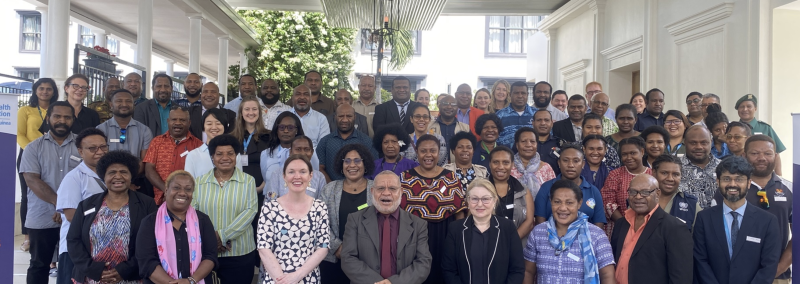
Papua New Guinea is the first country in the Western Pacific to leverage WHO’s strategic risk assessment tool to bolster emergency workforce capacities
Health workforce
Western Pacific Region
Papua New Guinea
Papua New Guinea (PNG) is the first country in the Western Pacific to use WHO’s Strategic Toolkit for Assessing Risks (STAR) to map emergency workforce capacities using an all-hazards approach. Over 50 experts have gathered at the National Strategic Risk Assessment for All-Hazards Workshop (18 – 21 February 2025), representing various ministries, institutions, and sectors, including: health, defence, security, rapid response teams, academia, industry, agriculture, environment, faith-based and non-governmental organisations. Participants will apply a stepwise process to identify hazards facing the country, assess their potential impact and prioritise actions to mitigate risks, including strengthening PNG’s emergency workforce. Workshop activities align with the Papua New Guinea national health plan 2021-2030, PNG’s National Disaster Risk Management Framework 2017-2030 and with other global frameworks such as the International Health Regulations (IHR 2005) and the Sendai Framework for Disaster Risk Reduction.
Pacific island countries, like Papua New Guinea, are increasingly impacted by climate-change related risks: landslides, tropical cyclones, flooding, storm surges, rising sea levels, and fluctuating weather patterns — that pose a significant threat to health security. The hazard-prone country is regularly exposed to earthquakes, tsunami, volcanic eruptions, and landslides. From 2010−2021, over 200,000 displacements associated with 47 disaster events were recorded across Papua New Guinea.
STAR enables countries to identify and mitigate risks and vulnerabilities associated with hazards, which, if not effectively managed, can result in the loss of health, lives and livelihoods. Through the national emergency risk profiling exercise, PNG will utilize evidence, collective experience, and expertise from multiple sectors to identify priority risks and map related emergency workforce capacities.
Speaking to the significance of this activity, Honourable Minister of Health, Elias Kapavore shared "The STAR workshop is another significant step towards building a stronger health emergency workforce for PNG and enhancing our ability to respond effectively during emergencies. We will use insights from the assessment to map PNG’s workforce capacities in relation to identified priority risks and direct resources to strengthen workforce readiness for future emergencies."
“By investing in our emergency workforce and prioritizing risk management, we are not only preparing for immediate challenges but also ensuring long-term resilience. This proactive approach will help us protect the health and well-being of our people, making PNG a safer place for everyone”, Minister Kapavore added.
A paradigm shift to reduce health risks.
WHO’s strategic risk-based approach to emergency management reflects a paradigm shift in managing risks: moving away from reactive, event-based, single-hazard, single-agency and top-down planning — towards a more collaborative, proactive, risk-based, all-hazard, multisectoral and participatory approach.
Elaborating on this shift in approach, Dr Sevil Huseynova, WHO Country Representative, Papua New Guinea noted: “Given the complex interdependencies between different sectors, reducing the risks and impacts of emergencies and disasters requires collective action. We can no longer work in silos.” The development of a strategic risk profile promotes a multisectoral, whole-of-society approach to identify, prepare for, and respond to risks ensuring that no one is left behind. “By bringing together emergency workforce from across sectors, as well as provincial and national levels, we can develop a more comprehensive plan to address gaps and strengthen workforce capacities,” she added.
Enabling rapid scale-up of emergency workforce capabilities.
Identifying gaps and solutions to strengthen emergency workforce capacities is critical to response readiness. WHO’s strategic risk assessment tool provides an avenue for countries to gain consensus on priority hazards and actions to strengthen related emergency workforce capabilities. Papua New Guinea will develop a landscape analysis for the workforce based on the priority risks flagged during the emergency risk profiling exercise, and strategically direct resources to strengthen national emergency workforce response capacities. The exercise provides an opportunity to think through critical emergency scenarios, map strengths and gaps in the emergency workforce and work across sectors to identify priority solutions to prepare the emergency workforce for likely health emergencies or disasters. WHO’s strategic risk assessment tool thus serves as a catalyst for rapid scale-up of emergency workforce capabilities.
Papua New Guinea’s workforce mapping exercise is an example of how WHO’s Global Health Emergency Corps Initiative (GHEC) is being rolled out across countries in the Region. Through GHEC, WHO supports countries to strengthen, standardize and scale national health emergency workforce capacities. The Initiative also strengthens the ecosystem of networks and response mechanisms through which countries collaborate at regional and global levels.
WHO is grateful for contributions from the Gates Foundation, the Australian Department of Foreign Affairs and Trade and the National Critical Care and Trauma Response Centre that have made this work possible.